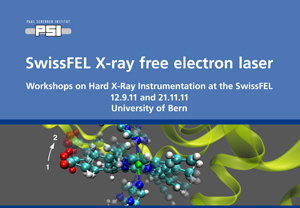Speaker
Annick Froideval
(Paul Scherrer Institute / Nuclear Energy and Safety)
Description
The radiation tolerance of materials in nuclear reactors is an important issue for the safe operation of current and future advanced nuclear plants. During reactor operation, irradiation-induced defects can form in nuclear reactor components such as fuels, fuel claddings (Zr-alloys), and (advanced) reactor pressure vessels. The nuclear materials of concern represent steels, ceramics, composite materials, and graphite used in high temperature reactors (HTR). The fundamental origin of irradiation damage can be investigated using molecular dynamics simulations [1]. However, no real-time measurement has so far been reported in the literature.
A «pump-probe» coherent scattering experiment is thus proposed: the process could be triggered by a synchronized high energy ion (the pump), the probe consisting of diffuse scattering of the X-ray FEL pulse [2, 3]. Such an experimental methodology would determine statistical features of the material’s structure development of irradiation cascades directly after their initiation, and their dependence on e.g. the nature and the energy of the incident particles. The statistical nature of the formation of the primary interstitial and vacancy defects and their nanometer-sized clusters leading to dislocation loops, and precipitates, as well as the evolution of their structure, distribution, and mobility, should in principle be accessible on a time scale of ~ 0.1-100 ps. The average size and density of the central vacancy cluster and the diffusion rate of the defect clusters should be obtained through correlation analysis of scattering. Such time-resolved X-ray diffuse scattering experiments could help to gain deeper insight into the cascade dynamics and defect evolution at early stages in nuclear materials. Moreover, such experimental results will then be compared to molecular dynamics simulations, allowing the experimental validation of the simulation methods, as well as a better understanding of the materials’ resistance to particle irradiation.
[1] F. Devynck and M. Krack, "Dynamics of irradiation-induced defects in nuclear materials: a proposed ion pump - X-ray FEL probe experimental approach", contribution to the Workshop on Petawatt Lasers at Hard X-Ray Light Sources, Dresden-Rossendorf, September 5-9, 2011 (http://www.hzdr.de/db/Cms?pNid=2362).
[2] B. D. Patterson (Ed.), Ultrafast Phenomena at the Nanoscale: Science Opportunities at the SwissFEL X-Ray Laser, PSI Report Nr. 09-10, 2009.
[3] A. Froideval, A. Badillo, J. Bertsch, S. Churakov, R. Dähn, C. Degueldre, T. Lind, D. Paladino, B. D. Patterson, Journal of Nuclear Materials, 416 (2011) 242-251.
Author
Annick Froideval
(Paul Scherrer Institute / Nuclear Energy and Safety)
Co-authors
Bruce Patterson
(Paul Scherrer Institute, SwissFEL Project)
Claude Degueldre
(Paul Scherrer Institute / Nuclear Energy and Safety)
Goutam Kuri
(Paul Scherrer Institute / Nuclear Energy and Safety)
Jiachao Chen
(Paul Scherrer Institute / Nuclear Energy and Safety)
Manuel A. Pouchon
(Paul Scherrer Institute / Nuclear Energy and Safety)
Matthias Krack
(Paul Scherrer Institute / Nuclear Energy and Safety)
Matthias Martin
(Paul Scherrer Institute / Nuclear Energy and Safety)
Stéphane Portier
(Paul Scherrer Institute / Nuclear Energy and Safety)

